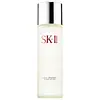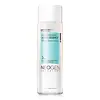What's inside
What's inside
 Key Ingredients
Key Ingredients

 Benefits
Benefits

 Concerns
Concerns

No concerns
 Ingredients Side-by-side
Ingredients Side-by-side

Bifida Ferment Lysate
Skin ConditioningSaccharomyces Ferment Filtrate
HumectantBetula Platyphylla Japonica Juice
Skin ConditioningRice Ferment Filtrate
Skin ConditioningAspergillus Ferment
Skin ConditioningGlycerin
HumectantDipropylene Glycol
HumectantMethyl Gluceth-20
HumectantWater
Skin ConditioningBetaine
HumectantCamellia Sinensis Leaf Extract
AntimicrobialEthylhexylglycerin
Skin ConditioningTrehalose
HumectantLactobacillus
Skin ConditioningPEG-60 Hydrogenated Castor Oil
EmulsifyingCaprylyl Glycol
EmollientTrideceth-10
CleansingAcrylates/C10-30 Alkyl Acrylate Crosspolymer
Emulsion StabilisingTromethamine
Buffering1,2-Hexanediol
Skin ConditioningTropolone
Skin ConditioningAllantoin
Skin ConditioningButylene Glycol
HumectantCoptis Japonica Extract
AntimicrobialArginine
MaskingHydroxypropyl Methylcellulose
Emulsion StabilisingHydrogenated Lecithin
EmulsifyingCI 77220
Cosmetic ColorantSodium Hyaluronate
HumectantAdenosine
Skin ConditioningNiacinamide
SmoothingDextrin
AbsorbentGlycine
BufferingSerine
MaskingGlutamic Acid
HumectantAspartic Acid
MaskingLeucine
Skin ConditioningAlanine
MaskingLysine
Skin ConditioningTyrosine
MaskingPhenylalanine
MaskingProline
Skin ConditioningThreonine
Valine
MaskingIsoleucine
Skin ConditioningPhenoxyethanol
PreservativeHistidine
HumectantMethionine
Skin ConditioningCysteine
AntioxidantBifida Ferment Lysate, Saccharomyces Ferment Filtrate, Betula Platyphylla Japonica Juice, Rice Ferment Filtrate, Aspergillus Ferment, Glycerin, Dipropylene Glycol, Methyl Gluceth-20, Water, Betaine, Camellia Sinensis Leaf Extract, Ethylhexylglycerin, Trehalose, Lactobacillus, PEG-60 Hydrogenated Castor Oil, Caprylyl Glycol, Trideceth-10, Acrylates/C10-30 Alkyl Acrylate Crosspolymer, Tromethamine, 1,2-Hexanediol, Tropolone, Allantoin, Butylene Glycol, Coptis Japonica Extract, Arginine, Hydroxypropyl Methylcellulose, Hydrogenated Lecithin, CI 77220, Sodium Hyaluronate, Adenosine, Niacinamide, Dextrin, Glycine, Serine, Glutamic Acid, Aspartic Acid, Leucine, Alanine, Lysine, Tyrosine, Phenylalanine, Proline, Threonine, Valine, Isoleucine, Phenoxyethanol, Histidine, Methionine, Cysteine
 Reviews
Reviews

Ingredients Explained
These ingredients are found in both products.
Ingredients higher up in an ingredient list are typically present in a larger amount.
Butylene Glycol (or BG) is used within cosmetic products for a few different reasons:
Overall, Butylene Glycol is a safe and well-rounded ingredient that works well with other ingredients.
Though this ingredient works well with most skin types, some people with sensitive skin may experience a reaction such as allergic rashes, closed comedones, or itchiness.
Learn more about Butylene GlycolGlycerin is already naturally found in your skin. It helps moisturize and protect your skin.
A study from 2016 found glycerin to be more effective as a humectant than AHAs and hyaluronic acid.
As a humectant, it helps the skin stay hydrated by pulling moisture to your skin. The low molecular weight of glycerin allows it to pull moisture into the deeper layers of your skin.
Hydrated skin improves your skin barrier; Your skin barrier helps protect against irritants and bacteria.
Glycerin has also been found to have antimicrobial and antiviral properties. Due to these properties, glycerin is often used in wound and burn treatments.
In cosmetics, glycerin is usually derived from plants such as soybean or palm. However, it can also be sourced from animals, such as tallow or animal fat.
This ingredient is organic, colorless, odorless, and non-toxic.
Glycerin is the name for this ingredient in American English. British English uses Glycerol/Glycerine.
Learn more about GlycerinSodium Hyaluronate is hyaluronic acid's salt form. It is commonly derived from the sodium salt of hyaluronic acid.
Like hyaluronic acid, it is great at holding water and acts as a humectant. This makes it a great skin hydrating ingredient.
Sodium Hyaluronate is naturally occurring in our bodies and is mostly found in eye fluid and joints.
These are some other common types of Hyaluronic Acid:
Learn more about Sodium HyaluronateWater. It's the most common cosmetic ingredient of all. You'll usually see it at the top of ingredient lists, meaning that it makes up the largest part of the product.
So why is it so popular? Water most often acts as a solvent - this means that it helps dissolve other ingredients into the formulation.
You'll also recognize water as that liquid we all need to stay alive. If you see this, drink a glass of water. Stay hydrated!
Learn more about Water